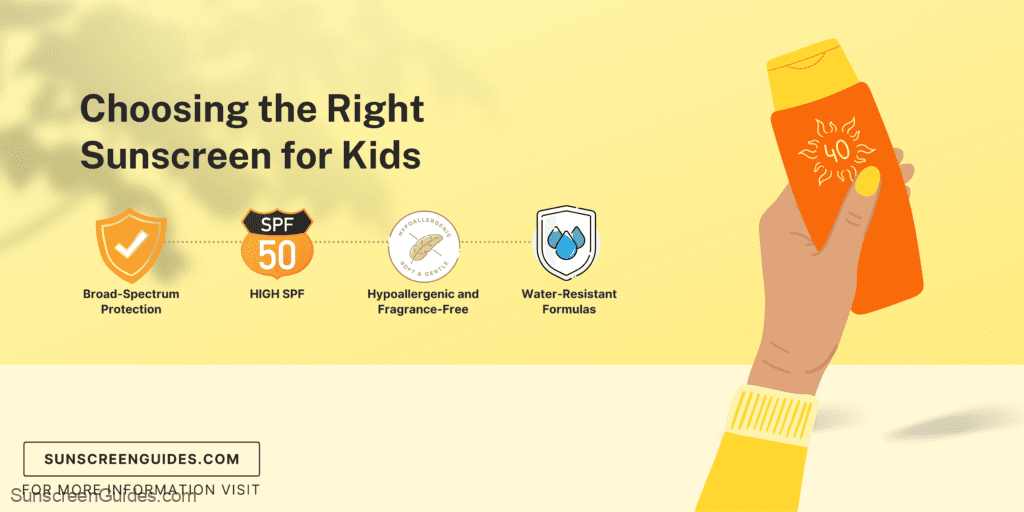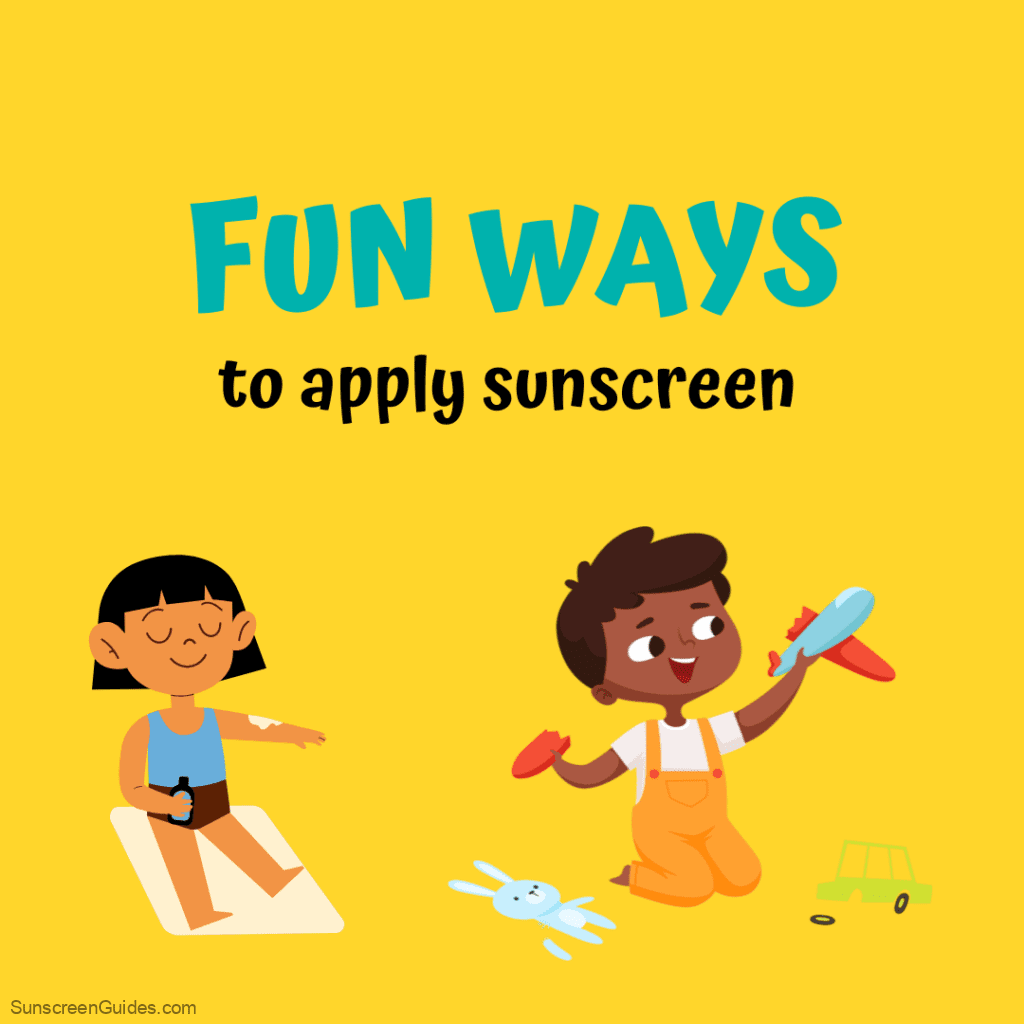As parents, we always strive to keep our children safe and healthy. When it comes to sun protection, it’s essential to take extra precautions for our little ones. Children’s delicate skin is more susceptible to sunburn and long-term damage from UV rays. In this comprehensive guide, we’ll explore the importance of sunscreen for kids, provide tips for choosing the right sunscreen, and offer strategies for ensuring proper application. Let’s dive in and learn how to safeguard our precious bundles of joy from the sun’s harmful rays.
Table of Contents
Understanding the Risks
Children’s skin is more sensitive and delicate than adults’, making them more vulnerable to the damaging effects of UV radiation. Sunburns during childhood can increase the risk of skin cancer later in life, including the most dangerous form, melanoma. It’s important to note that the effects of sun exposure are cumulative, meaning that each sunburn adds to the damage already incurred.

Aside from the increased risk of skin cancer, excessive sun exposure can lead to premature aging of the skin. This can manifest as wrinkles, fine lines, sunspots, and a loss of elasticity. While these effects may not be immediate during childhood, they become more apparent as the child grows older.
Furthermore, children’s immune systems are still developing, and their skin has a lower capacity to repair itself compared to adults. This means that the damage caused by UV rays can be more significant and take longer to heal. By understanding these risks, we can take proactive measures to protect our kids and prevent future complications.
It’s worth mentioning that protecting children from the sun goes beyond preventing sunburns. Prolonged sun exposure can also cause heat exhaustion or heatstroke, especially in hot climates. This is why it’s crucial to adopt a comprehensive approach to sun protection that includes sunscreen, appropriate clothing, shade, and hydration.
By educating ourselves about the risks and taking proactive steps to protect our children, we can minimize the potential harm caused by UV radiation. Sunscreen for kids plays a crucial role in this protective strategy, providing an extra layer of defense against the sun’s harmful rays. Let’s dive deeper into how we can choose the right sunscreen and ensure its proper application to keep our little ones safe and healthy.
Choosing the Right Sunscreen for Kids

When it comes to selecting sunscreen for kids, there are a few key factors to consider. Here’s what you need to know to make the best choice for your little ones:
- Broad-Spectrum Protection: Look for a sunscreen that offers broad-spectrum protection, which means it shields the skin from both UVA and UVB rays. UVA rays penetrate deep into the skin, leading to long-term damage, while UVB rays cause sunburn. Both types of radiation contribute to the risk of skin cancer. Broad-spectrum sunscreens provide comprehensive protection against these harmful rays.
- SPF (Sun Protection Factor): The SPF number indicates the level of protection against UVB rays. For kids, it’s recommended to use a sunscreen with a minimum SPF of 30. Higher SPF values offer increased protection, but it’s important to note that no sunscreen can provide 100% protection. Remember to reapply sunscreen regularly, especially after swimming or sweating.
- Physical or Mineral Sunscreens: Consider using physical or mineral sunscreens for children, particularly those with sensitive skin. These sunscreens contain active ingredients like zinc oxide or titanium dioxide, which create a physical barrier on the skin, reflecting and scattering the UV rays. They are generally gentler and less likely to cause skin irritation.
- Hypoallergenic and Fragrance-Free: Opt for sunscreens that are hypoallergenic and fragrance-free, as they are less likely to cause allergic reactions or skin irritations in children with sensitive skin. Check the product label for these specifications.
- Water-Resistant Formulas: Kids love to splash around in the water, so it’s essential to choose a water-resistant sunscreen. Look for a product labeled as “water-resistant” and follow the recommended reapplication frequency, typically every 80 minutes when swimming or sweating.
- Easy Application: Kids can be wiggly and impatient, so choose sunscreens that are easy to apply. Consider options with spray or lotion formulations that spread smoothly and evenly on the skin. Remember to pay extra attention to commonly missed areas like the ears, back of the neck, and tops of the feet.
Remember, sunscreen alone is not enough to protect your child from the sun’s harmful rays. Encourage them to wear protective clothing, such as hats, sunglasses, and lightweight long-sleeved shirts, and seek shade during peak sun hours. Combining these strategies will provide the best defense against sun damage.
By carefully selecting the right sunscreen for your kids and following proper application techniques, you can ensure that they enjoy the outdoors while staying protected from harmful UV radiation. Let’s explore some additional tips and tricks for applying sunscreen effectively to make it a hassle-free experience for both you and your little ones.
Application Techniques and Tips

Proper application of sunscreen is essential to ensure its effectiveness in protecting your child’s delicate skin. Here are some application techniques and tips to keep in mind:
- Apply Generously: Don’t skimp on sunscreen—apply it generously to all exposed areas of your child’s body. Be thorough and make sure you cover commonly overlooked areas like the ears, back of the neck, tops of the feet, and the back of the hands. Remember, it’s better to apply more than not enough.
- Time it Right: Apply sunscreen at least 15 to 30 minutes before sun exposure to allow the product to fully absorb into the skin. This ensures that the protective barrier is in place before your child steps outside. Reapply every two hours or more frequently if your child is swimming or sweating profusely.
- Use the Right Amount: Use about one ounce (approximately a palmful) of sunscreen for each application on your child’s body. Using too little may result in inadequate coverage and reduced sun protection.
- Rub it In: Take the time to rub the sunscreen into your child’s skin thoroughly. This ensures even distribution and helps the product adhere to the skin better. Pay extra attention to any areas that are prone to sunburn, such as the nose, cheeks, and shoulders.
- Don’t Forget the Lips: Lips are susceptible to sun damage too. Choose a lip balm with at least SPF 30 and apply it generously to protect your child’s lips from harmful UV rays.
- Reapply Frequently: Even if a sunscreen claims to be water-resistant, it’s crucial to reapply it regularly, especially after your child has been swimming or sweating. Water-resistant does not mean waterproof, and the protective layer of sunscreen can wear off over time.
- Encourage Self-Application: As your child grows older, encourage them to apply their own sunscreen under your supervision. Teach them the importance of proper application and the areas that need attention. This not only promotes independence but also instills good sun protection habits from an early age.
- Set a Good Example: Children learn by observing their parents’ behavior. Be a role model and apply sunscreen on yourself as well. This reinforces the importance of sun protection and encourages your child to make it a regular part of their routine.
Remember, sunscreen is just one part of a comprehensive sun protection strategy. Dress your child in lightweight, protective clothing, and provide them with a wide-brimmed hat and UV-blocking sunglasses. Seek shade during peak sun hours, usually between 10 am and 4 pm when the sun’s rays are strongest.
Sun-Safe Practices for Kids
In addition to using sunscreen, incorporating sun-safe practices into your child’s routine is crucial for their overall protection against harmful UV rays. Here are some important sun-safe practices to teach your kids:
- Seek Shade: Encourage your child to seek shade, especially during the peak hours of the day when the sun’s rays are the strongest. Trees, umbrellas, or canopies provide excellent natural shade options when spending time outdoors.
- Wear Protective Clothing: Dress your child in lightweight, loose-fitting clothing that covers their arms and legs. Look for clothing with a tight weave that provides better sun protection. Opt for long-sleeved shirts, long pants, and wide-brimmed hats to shield their face, neck, and ears from the sun.
- Use UV-Protective Swimwear: When swimming or participating in water activities, choose swimwear that offers built-in UPF (Ultraviolet Protection Factor) to provide extra sun protection. These garments are specifically designed to block harmful UV rays and cover more of the skin.
- UV-Blocking Sunglasses: Protect your child’s eyes from the sun’s harmful rays by providing them with sunglasses that offer 100% UV protection. Look for sunglasses labeled as UV400 or providing 100% UVA and UVB protection.
- Stay Hydrated: Remind your child to drink plenty of fluids, especially when spending time outdoors in the sun. Proper hydration helps prevent dehydration and supports overall skin health.
- Educate on Sunburn Signs: Teach your child to recognize the signs of sunburn, such as redness, pain, and peeling skin. If they experience any of these symptoms, encourage them to seek shade immediately and apply a cool compress to the affected area.
- Be Mindful of Reflection: Keep in mind that sand, water, and other reflective surfaces can intensify the sun’s rays. Remind your child to take extra precautions in these settings and reapply sunscreen more frequently.
- Encourage Fun Indoor Activities: On particularly hot or sunny days, suggest engaging in fun indoor activities to limit sun exposure. This could include arts and crafts, board games, reading, or movie time. There are plenty of enjoyable alternatives that keep your child entertained while avoiding excessive sun exposure.
By incorporating these sun-safe practices into your child’s routine, you can help them develop healthy habits that prioritize their skin’s protection from the sun.
Fun Ways to Promote Sun Protection

Teaching kids about sun protection doesn’t have to be boring or tedious. In fact, you can make it a fun and interactive experience that they’ll remember. Here are some creative and entertaining ways to promote sun protection for kids:
- Sunscreen Art: Turn applying sunscreen into a creative activity by encouraging your child to draw fun designs or patterns on their skin using sunscreen. Let them use their imagination and create their own unique sunscreen art. This not only makes the process more enjoyable but also ensures that the sunscreen is evenly applied.
- Sun Safety Games: Create engaging games that educate kids about sun safety. For example, you can set up a “Sun Safety Trivia” game where you ask questions about sun protection and reward them with small prizes for correct answers. Another idea is to organize a treasure hunt where they have to find hidden sun protection items like hats, sunglasses, and sunscreen.
- UV-Sensitive Accessories: Invest in UV-sensitive accessories like color-changing bracelets or stickers that react to sunlight. These accessories change color when exposed to UV rays, indicating that it’s time to reapply sunscreen or seek shade. Kids will enjoy the interactive aspect of these items and become more aware of sun protection.
- Sun-Safe Dress-Up: Organize a dress-up event where kids can pretend to be “sun heroes” by dressing up in sun-safe clothing and accessories. Let them choose their outfits, including long-sleeved shirts, wide-brimmed hats, and UV-protective sunglasses. Take pictures and celebrate their commitment to sun protection.
- Sunscreen Song or Dance: Create a catchy song or dance routine that emphasizes the importance of wearing sunscreen. You can come up with simple lyrics and moves that kids can easily learn and perform. Encourage them to sing or dance along whenever it’s time to apply sunscreen.
- Storytelling: Use storytelling to teach kids about sun protection. Create or find children’s books that revolve around sun safety and read them together. Afterward, engage in a discussion about the importance of protecting their skin from the sun’s rays.
- Role-Playing: Encourage imaginative play where kids can pretend to be “sun superheroes” or “sun safety ambassadors.” Provide them with capes, hats, and sunscreen accessories to enhance their role-playing experience. This helps instill a sense of responsibility and pride in taking care of their skin.
- Outdoor Shade Retreats: Set up outdoor shade retreats in your backyard or local park. Create a cozy space with blankets, cushions, and umbrellas where kids can relax, read, or play games while staying protected from the sun. This encourages them to seek shade when needed and enjoy outdoor activities in a sun-safe environment.
By incorporating these fun and interactive activities, you can make sun protection an enjoyable part of your child’s routine while instilling important habits that will benefit them throughout their lives.
Conclusion
By prioritizing sun protection for our children, we can instill healthy habits that will benefit them throughout their lives. Sunscreen for kids is a vital tool in safeguarding their delicate skin from harmful UV rays. Remember to choose the right sunscreen, apply it correctly, and reinforce sun-safe practices. With our love and care, we can protect our little ones and create a sun-smart generation.
Don’t forget to check American Academy of Dermatology How Parents Can Keep Their Baby Safe. And our article
